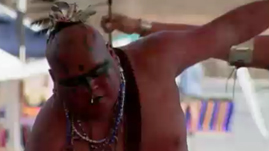Teachers' Domain - Digital Media for the Classroom and Professional Development
User: Preview



The Warriors of AniKituhwa perform the Eagle Dance at the 2006 Festival of Native Peoples. Like other dances from Cherokee culture, the Eagle Dance serves as a catalyst for people to come forward and share their memories and a way to preserve cultural traditions.
This resource is part of the Native American Culture collection.
Find additional arts resources for your classroom at the KET Arts Toolkit website.
Native American cultures have gone to great lengths to maintain their traditions, including dance. In the early days of reservation life, this was often extremely difficult. “Indian agents,” who were often Christian missionaries, tended to believe that the practice of dance should be repressed, and people had to gather in remote corners of their reservations in order to practice their ceremonies and dances. Because many ceremonies and dances had to be performed at certain times of the year and at particular sites, some of this heritage was lost forever.
The Warriors of AniKituhwa is a dance group founded in 2003 to bring back to life traditional Cherokee dances.The dancers are honored as cultural ambassadors of the Eastern Band of Cherokee and provide workshops on Cherokee dance traditions, as well as researching and performing Cherokee dances from the 1700s.
The Eagle Dance or War Dance is a ceremonial dance that was used to prepare for battle, but it was also used when meeting with other nations to negotiate for peace. It symbolizes the strength of the Cherokee nation and the commitment of the warriors to their people. The red paint the dancers use is made from a combination of bear grease and red ochre. The bear grease represents the strength of the bear, and the red ochre represents blood or life. The dancers wear it as a symbol of their pure commitment to action in confronting fear, especially in battle and on the hunt. The dancers carry replicas of the war clubs that were used in hand-to-hand combat. The mission of the warriors has now changed: the new struggle is to preserve Cherokee culture and carry on the tradition to future generations.
The War Dance also served Cherokee society as a means of helping families who were in distress. As the warriors danced, each warrior would throw something of value such as furs or wampum (polished beads of shell used as money, ornaments, or ceremonial pledges) on a large skin. After the dance, the items were distributed to the families in need.
 Loading Standards
Loading Standards